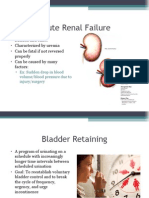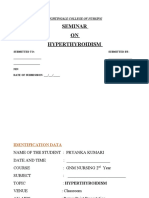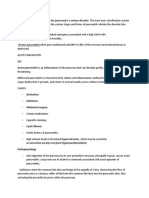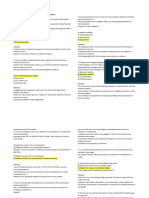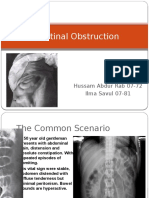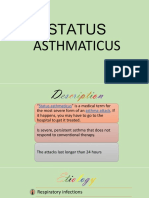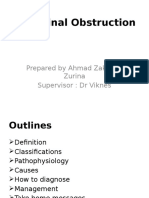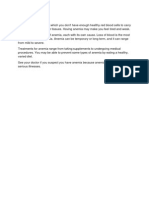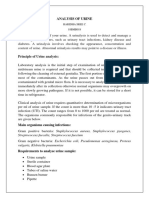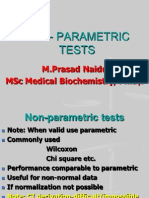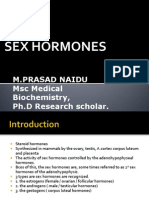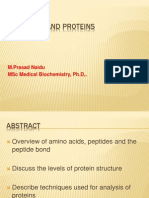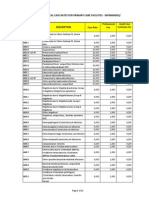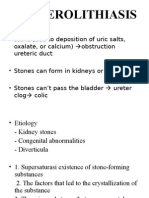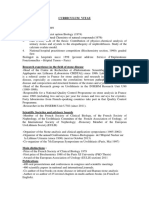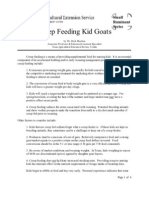Renal Calculi
Renal Calculi
Uploaded by
Dr. M. Prasad NaiduCopyright:
Available Formats
Renal Calculi
Renal Calculi
Uploaded by
Dr. M. Prasad NaiduOriginal Description:
Copyright
Available Formats
Share this document
Did you find this document useful?
Is this content inappropriate?
Copyright:
Available Formats
Renal Calculi
Renal Calculi
Uploaded by
Dr. M. Prasad NaiduCopyright:
Available Formats
M.
Prasad Naidu
Msc Medical Biochemistry,
Ph.D. research scholar
Renal calculi:
The smooth epithileal tissue are formed the hardness by the
inorganic and organic substance like
kidney--------- stone ( calcium)
gall bladder---- stone ( cholesterol oxalates)
intestine ------- jejunum (hard substance)
Introduction:
Urinary calculi are mainly composed of substance normally in
urine and may be found in any part of the urinary tract. Their
size of an egg. These calculi can be divided into:
Simple calculi
Mixed calculi
Foreign body calculi
Formatin: The nucleus for stone can be obtained by the
presence of a small lesion. The crystals get deposited on the
nucleus and continue to grow. These can some times adhere
to the renal papillae.
Substances found in calculi : They are mainly uric acid, urate
, triple phosphate, calcium carbonate ,calcium phosphate,
calcium oxalates, cholesterol. Cystine calculi have been
reported but are extremly rare, and xanthin also form stones (
xanthinuria)
COMPARATIVE INCIDENCES OF FORMS OF URINARY LITHIASIS
Stone analysis in Percentage
Form of Lithiasis India USA Japan UK
Pure Calcium Oxalate 86.1 33 17.4 39.4
Mixed Calcium Oxalate and 4.9 34 50.8 20.2
Phosphate
Magnesium Ammonium 2.7 15 17.4 15.4
Phosphate (Struvite )
Uric Acid 1.2 8.0 4.4 8.0
Cystine 0.4 3.0 1.0 2.8
Inhibitors & Promoters of Stone Formation in Urine
INHIBITORS
Inhibits crystal Growth -
Citrate complexes with Ca
Magnesium complexes
with oxalates
Pyrphosphate - complexes
with Ca
Zinc
Inhibits crystal Aggregation
Glycosaminoglycans
Tamm- Horsfall Protein
PROMOTERS
Bacterial Infection
Anatomic Abnormalities
PUJ obst., MSK
Altered Ca and oxalate
transport in renal epithelia
Prolonged immobilisation
Increased uric acid levels I.e
taking increased purine
subs promotes
crystalisation of Ca and
oxalate
TYPES OF RENAL / URETER STONES
Common stones:
OXALATE (CALCIUM OXALATE)
PHOSPHATE
URIC ACID / URATE
CYSTINE
Uncommon Stones
XANTHINE STONES
(Autosomal Recessive . Def of Xanthine Oxidase leading to Xanthinuria)
DIHYDROXY ADENINE STONE
( Def. of enzyme adenine phospo ribosyl transferase )
SlLICATE STONES
Rare in humans ( excess intake of Antacid with Mg Trisilicate. Mostly in cattle due to
ingestion of Sand )
MATRIX
- Infection by Proteus - Radiolucent (all calculi have some amt ( 3%) of matrix but
matrix calculus has 65% Matrix content in calculi)
Stones BIO Chemical Constituents
Whewelite Calcium Oxalate Monohydrate CaC
2
O
4
-H
2
O
Weddelite - Calcium Oxalate dihydrate CaC
2
O
4
-2H
2
O
Brushite Calcium Hydrogen phosphate dihydrate CaHPO
4
2H
2
O
Whitlockite - TriCalcium Phosphate Ca
2
(PO
4
)
2
Struvite Magnesium Ammonium hexahydrate MgNH
4
PO
4
-6H
2
O
D/D of Radiolucent filling defect on IVU in Ureter or Kidney
Must Know
Uric Acid Calculus
Matrix Calculus
Sloughed Papilla
Blood Clots
TCC
Renal Cysts
Vascular Lesions
Know For Brownie Points
Xanthine Calculus
Hydroxy adenine Calculus
Ephederine Calculus
Infection due to gas forming Org.
Fungal Ball
Tuberculoma
Malacoplakia
Hyper trophied Papilla
Renal pseudo-tumour
OXALATE (CALCIUM OXALATE)
ALSO CALLED MULBERRY STONE
COVERED WITH SHARP PROJECTIONS
SHARP MAKES KIDNEY BLEED (HAEMATURIA)
VERY HARD
RADIO - OPAQUE
Under microscope looks like Hourglass or Dumbbell shape if monohydrate and
Like an Envelope if Dihydrate
Bio chemical test for oxalate stone
Procedure:
Make fine powder
Add 2 to 3 drops of 10% Hcl
Cool it and add pinch Mn O2- do not mix
Result: fomation of gas bubbles form bottom
PHOSPHATE STONE
USUALLY CALCIUM PHOSPHATE
SOMETIMES CALCIUM MAGNESIUM AMMONIUM
PHOSPHATE OR TRIPLE PHOSPHATE
SMOOTH MINIMUM SYMPTOMS
DIRTY WHITE
RADIO - OPAQUE
Calcium Phosphate also called Brushite appears like Needle shape under
microscope
Bio chemical test for phosphate stone
Procedure:
Make fine powder
Add o.5ml of ammonium molybdate warm over a gas flame
Results: formation of yellow precipitate.
PHOSPHATE STONES
IN ALKALINE URINE
ENLARGES RAPIDLY
TAKE SHAPE OF CALYCES
STAGHORN
CALCIUM PHOSPHATE STONES
Hyperparathyroidism Ca P
Renal Tubular Acidosis K CO
2
Medullary Sponge Kidney -
PTH Hormone Promotes renal production of 1-25-dihyroxycholecalciferol active Vit.D and also
increases absorption of Calcium and decreases Phosphorus absorption from Kidneys
URIC ACID & URATE STONE
HARD & SMOOTH
MULTIPLE
YELLOW OR RED-BROWN
RADIO - LUCENT (USE ULTRASOUND)
pKa of uric acid 5.75 at this pH 50% of uric acid insoluble.
If pH falls further - uric acid more insoluble
Bio chemical test for urate stone
Murexide test
Procedure:
Make fine powder of the stone by using mortor
Take a pinch of the powder in a test tube
Add 1 drop of 20g/dl Na2 Co3.
Add 2drops of phopho tungstic acid reagent
Results : formation of deep blue color.
Clinical significance: gout
CYSTINE STONE
AUTOSOMAL RECESIVE DISORDER
USUALLY IN YOUNG GIRLS
DUE TO CYSTINURIA -
CYSTINE NOT ABSORBED BY TUBULES
MULTIPLE
SOFT OR HARD can form stag-horns
PINK OR YELLOW
RADIO-OPAQUE
Under microscope appears like hexagonal or benezene
ring ask for first morning sample
CYSTINE STONE - Management
High Fluid Intake and Alkalanise Urine dissolve most of the
smaller cystine stones
D-Pencillamine or MPG (Mercaptopropionylglycine) binds to
cystine that is soluble in urine
Side effects of Pencillamine restricts it use Allergic rashes, GI
problems- Nausea, Vomiting, Diarrhoea
MPG better tolerated
Large obstructive stones Surgery required first
Cyanide Nitroprusside Calorimeteric Test for detecting Cystinuria. If positive do
amino acid chromatography
Bio chemical test for cystine stone
Procedure:
Make fine powder
Add 1 drop of ammonium hydrooxide reagent and one drop of
Na Cl reagent, wait for 5 min
add 2-3 drops of sodium nitroprusside reagent
Result: beet red color changes to orange is standing
Clinical significance: cystinuria
Cause of Stone Disease
Supersaturation of urine is the key to stone formation
Intermittent supersaturation - Dehydration
Crystal aggregation
Anatomic Abnormailities PUJ , MSK
Bacterial Infection
Defects in transport of Calcium and Oxalate by Renal
epithelia
E.Coli infection increases matrix content in urine . Proteus makes urine alkaline
Surgical Conditions and Stone Disease
Regional ileitis and Ileal Bypass Surgery for eg
Obesity can lead to increase oxalate absorption and
stone ds
ileostomies - In Chr. Diarrhoea with Bicabonate
loss systemic acidosis and acidic urine increases
risk of Uric Acid stones
HISTORY
A. IS PATIENT DRINKING ENOUGH ?
B. PROFESSION
C. ENQUIRE ABOUT UTI STONES
D. FAMILY HISTORY
E. LONG ILLNESS BEDRIDDEN STONES
MANAGEMENT OF STONES
HISTORY :
A. FIND OUT IF DRINKING ENOUGH LIQUIDS
(NOT DRINKING ENOUGH IMPORTANT CAUSE OF
STONE FORMATION & GROWTH)
HISTORY (Cont...)
B. ASK ABOUT THEIR PROFESSION
DEHYDRATION STONES CAN FORM e.g.
MARATHON
WORK NEAR A FURNACE,
BRICK - LAYER, LABOURERS & WEAVERS
TRUCK & BUS DRIVERS
CLINICAL FEATURES
1. PAIN IN 75 % OF THE CASES
RENAL COLIC IF SEVERE AND ACUTE
A) KIDNEY STONE
FIXED PAIN IN THE LOIN
B) URETERIC STONE
PAIN RADIATES LOIN TO GROIN
CLINICAL FEATURES (Contd....)
2) HAEMATURIA
CAN BE FRANK
OR ONLY FOUND ON DIP - STICK OR LAB.
3) PYURIA - IF INFECTION CAN HAVE PUS IN URINE
Clinical Features
acute obstruction of
ureter---severe colic
flank pain referred to
genitalia
nausea, vomiting may
mislead and look like gi
problem
microhematuria likely
chronic stone dis. tends
to be associated with
large or multiple stones
can be little or no pain
may have impaired
renal function, anemia,
weight loss etc.
concomitant infection
more likely
Clinical Risk Factors
occupation
family history
diet
hydration
small bowel disease (i.b.d.)
medical conditions causing hypercalcuria
medical conditions causing aciduria
ON EXAMINATION
1. ACUTE PRESENTATION
ABDOMEN TENSE AND RIGID
TENDERNESS PRESENT IN THE LOIN
2. ASSYMPTOMATIC PRESENTATION
NO TENDERNESS, FINDINGS IN ABDOMEN
INVESTIGATIONS
1. FULL BLOOD COUNT TO CHECK FOR
(ANAEMIA IF GOING FOR SURGERY)
2. SERUM ELECTROLYTES / UREA / CREATININE / CALCIUM / URIC ACID / PHOSPHATE/
BICARBONATES
3. 24-HOURS URINE FOR ELECTROLYTES
(Only if recurrent stone former)
CALCIUM / OXALATE / URIC ACID /
CYSTINE / CITRATE/ URATES
INVESTIGATIONS (Cont...)
4. PLAIN KUB X-RAY OF ABDOMEN (Mandatory)
5. IVU OR IVP (INTRA VENOUS UROGRAM)
Not Mandatory
Useful for radio-lucent stones & to detect Congenital Anomalies in Urinary tracts
6. ULTRASOUND (Mandatory)
7. CT TO LOOK AT UNUSUAL ANATOMY OF THE KIDNEY (To differentiate
cause of acute colic stone or anuria Suspected due to stone disease)
Bilateral Ureteric Calculus in a patient presenting with Anuria
Helical or Spiral CT provides 3D reconstruction. Helical refers to path the X ray follows on
Gantry. These are rapidly performed and do not require contrast agents for reconstruction.
MANAGEMENT OF UROLITHIASIS
Non-invasive approach to urinary calculas-HALLMARK of last
20 yrs.
Lithotripters
1.Extra Corporeal Shock wave
2.Intra Corporeal
Better fiber optics Mini turisation of Telescopes
Accessories - Innovative variety
Modern Management of Urolithiasis
ESWL
Ureterorenoscopy
Percutaneous Nephrolithotomy
Laparoscopic Approach to stones
Open Ureterolithotomy, Pyelolithotomy or Nephropyelolithotomy is required in less
than 1 to 2% of modern stone management
EXTRA - CORPOREAL SHOCK WAVE LITHOTRIPSY
(ESWL)
SHOCK WAVES GENERATED UNDER WATER CAN TRAVEL
THROUGH BODY WITHOUT ANY APPRECIABLE LOSS OF
ENERGY. WHEN THEY ENCOUNTER STONES THE
CHANGES IN DENSITY CAUSES ENERGY TO BE ABSORBED
AND REFLECTED BY THE STONE & THIS RESULTS IN
FRAGMENTATION OF THE STONES.
ESWL For Urinary Tract Calculus
ESWL
Absolute Contra-indication-
Pregnancy
Relative Contra-Indications for ESWL
Renal Colic
Urinary obstruction
Infection
Declining Renal Function
Significant Hematuria
ESWL COMPLICATIONS
Haematuria is quite common ( short term
antibiotics Recommended )
Incomplete stone Fragmentation & Obstruction
Stienstrasse ( stone street ) usually due to a large
Leading fragment
( Stents Recommended prior to ESWL for Calculi >
1.5 cm )
Renal Lithiasis Blood Pressure Study
(Patients treated 1984-1986 Dallus Study)
First Follow Up Second Follow Up
1988 1990
No.Pts Annualized Rate No. Pts Annualized Rate
of Hypertension of Hypertension
ESWL 771 2.5% 590 2.1%
non-ESWL 195 3.8% 155 1.6%
Total 966 745
Diet & Fluid Advice
High Fluid Intake
Restrict Salt (Na)
Oxalate Restrict
Avoid high intake of Purine food
Increased citrus fruits may help
If hypercalciuria restrict Ca intake
Role of Potassium Citrate in preventing Cal Oxalate stone ds KCit lowers
urinary calcium whereas Na Citrate does not lower Calcium due to Sodium load
Moderate Amounts : High Amounts :
Apple Juice Cocoa
Beer Fresh Tea
Coffee
Cola
FOODS :
Almonds, Asparagus, Cashew Nuts, Currants, Greens,
Plums, Raspberries, Spinach
Clinical significance of Renal Stones
all urinary stones are composed of 98% crystalline material
and 2% mucoprotein
the crystalline component(s) may be found pure or in
combination with each other.
the common characteristic that all crystalline components
share, is that they have a very limited solubility in urine
99% of renal stones (in western hemisphere) are composed of:
calcium oxalate 75% (mono or di hydrate)
calcium hydroxyl phosphate (15%)(apatite)
magnesium ammonium phosphate 10% (struvite)
uric acid 5%
cystine 1%
investigations show that the formation of a stone is similar to
the development of a crystalline mass in vitro
given that stone formation is an example of crystallization one
could predict:
the necessity for a supersaturated state in urine
the occurrence of spontaneous crystallization
the need for the earliest polycrystalline state to be arrested in
the u.t. allowing time for growth
Spontaneous Crystallization
normal urine has crystals (at times)
normal urine is extremely effective in maintaining a stable
supersaturated state
there are certain components of urine that
enhance ability to maintain ss state
inhibit development of crystals
Principles of Stone Prevention
prevent supersaturation
water! water and more water enough to make 2L of urine per day
prevent solute overload by low oxalate and moderate Ca intake
and treatment of hypercalcuria
replace solubilizers i.e... citrate
manipulate pH in case of uric acid and cystine
flush! forced water intake after any dehydration
Treatment Renal Stones
> 2cm or multiple stones, percutaneous ultrasonic lithotripsy
(pul)
large branched stones staghorn may require pul and eswl.
cystine stones pul or open nephrolithotomy
MAJORITY : 80 TO 85 % of all stones can be treated by -
EXTRA - CORPOREAL SHOCK WAVE LITHOTRIPSY (ESWL)
MINORITY : 15 TO 20 % SHOULD NEED MINIMALLY INVASIVE SURGERY
(PCNL / URETEROSCOPY)
(LESS THAN 1 % SHOULD NEED OPEN SURGERY)
Treatment:
small ureteral stones
with good chance of
passage (<7 mms)
allow time to pass (2-4
weeks)
lower ureter-
ureteroscopic stone
removal
mid-upper ureter eswl
large ureteral stones
(>7mms)
eswl
ureteroscopic stone
fragmentation
open surgery
You might also like
- GERDDocument11 pagesGERDJenadi BinartoNo ratings yet
- Cirohsis of LiverDocument29 pagesCirohsis of LiverAnonymous L95gMHSNo ratings yet
- Assessment of The Endocrine SystemDocument29 pagesAssessment of The Endocrine SystemBintang Banyu Biru100% (1)
- CholelithiasisDocument65 pagesCholelithiasisGAURAV0% (1)
- ABC Dictionary of Urinary SystemDocument26 pagesABC Dictionary of Urinary Systemaby_romero9750% (2)
- Urological Disorders of The Dog and CatDocument177 pagesUrological Disorders of The Dog and CatChiruc AmaliaNo ratings yet
- NEET-SS General SurgeryDocument63 pagesNEET-SS General Surgeryadi100% (2)
- Acid-Fast Stain (Ziehl-Neelsen Stain)Document15 pagesAcid-Fast Stain (Ziehl-Neelsen Stain)ASHUTOSH KHADANGANo ratings yet
- Pathological Changes of DM - 2023Document53 pagesPathological Changes of DM - 2023Visura PrabodNo ratings yet
- GoiterDocument17 pagesGoiterShaimaa EmadNo ratings yet
- Renal Calculi (NS Presentation)Document24 pagesRenal Calculi (NS Presentation)Norsyakira NawirNo ratings yet
- Idiopathic Thrombocytopenic PurpuraDocument8 pagesIdiopathic Thrombocytopenic PurpuraMonette Abalos MendovaNo ratings yet
- Urine Specimen Collection Procedure PDFDocument3 pagesUrine Specimen Collection Procedure PDFtincho9No ratings yet
- SEMINAR On HyperthyroidismDocument17 pagesSEMINAR On HyperthyroidismAmit RanjanNo ratings yet
- Pancreatitis: Def Pancreatitis (Inflammation of The Pancreas) Is A Serious Disorder. The Most Basic Classification SystemDocument5 pagesPancreatitis: Def Pancreatitis (Inflammation of The Pancreas) Is A Serious Disorder. The Most Basic Classification SystemSanthu Su100% (2)
- Peptic Ulcer DiseaseDocument18 pagesPeptic Ulcer DiseasechetankumarbhumireddyNo ratings yet
- Case Presentation Hepatitis A LuluDocument28 pagesCase Presentation Hepatitis A LuluBrenda KarinaNo ratings yet
- Congenital Anomalies of KidneDocument7 pagesCongenital Anomalies of KidneSanthosh.S.U100% (2)
- History and Physical Assessment of Integumentary System: By: Mr. M - Shiva Nanda ReddyDocument84 pagesHistory and Physical Assessment of Integumentary System: By: Mr. M - Shiva Nanda ReddyNilakshi Barik MandalNo ratings yet
- Sputum ExaminationDocument31 pagesSputum ExaminationMalliga Sundareshan100% (1)
- ReviewerDocument31 pagesReviewerKrystelle Jade LabineNo ratings yet
- Hepatic EncephalopathyDocument3 pagesHepatic EncephalopathySuhas KandeNo ratings yet
- Intestinal ObstructionDocument120 pagesIntestinal ObstructionHussam Abdur RabNo ratings yet
- Renal Biopsy Nursing Guideline-4 - 1Document4 pagesRenal Biopsy Nursing Guideline-4 - 1Aslam AssandakaniNo ratings yet
- Therap Case 3Document18 pagesTherap Case 3Safoora RafeeqNo ratings yet
- Joint Commission International Accreditation (Jcia) : - Presented By:-Manoj.P 142803008Document23 pagesJoint Commission International Accreditation (Jcia) : - Presented By:-Manoj.P 142803008Anonymous 6beVxFNo ratings yet
- MumpsDocument11 pagesMumpscasandra moranteNo ratings yet
- Liver CirrhosisDocument15 pagesLiver CirrhosisAngelica Mercado Sirot100% (1)
- Presentation On Renal CalculiDocument16 pagesPresentation On Renal CalculiSangay CheshireNo ratings yet
- Status AsthmaticusDocument15 pagesStatus AsthmaticusDaianne Joy DonatoNo ratings yet
- Pleural Effusion: Presented By:-Gayathri Gopakumar BSC - Nursing 2 YearDocument30 pagesPleural Effusion: Presented By:-Gayathri Gopakumar BSC - Nursing 2 YearGAYATHRI GOPAKUMARNo ratings yet
- Acute Renal FailureDocument17 pagesAcute Renal FailureDina Rasmita100% (1)
- Asphyxia NeonatorumDocument30 pagesAsphyxia Neonatorumwizborrlyzo006No ratings yet
- Management of Severe DehydrationDocument64 pagesManagement of Severe DehydrationIgbashioNo ratings yet
- Non Viral HepatitisDocument8 pagesNon Viral HepatitisKeith Wesley YbutNo ratings yet
- PYELONEPHRITISDocument16 pagesPYELONEPHRITISshenecajean carajay100% (1)
- Nursing Management of The Unconscious PatientDocument34 pagesNursing Management of The Unconscious Patientcamaralamin209_54266100% (2)
- Viral Hepatitis: Dr. Khaled JadallahDocument24 pagesViral Hepatitis: Dr. Khaled JadallahRashed ShatnawiNo ratings yet
- DermatosesDocument12 pagesDermatosesnjoom100% (1)
- Intestinal Obstruction 4Document25 pagesIntestinal Obstruction 4Muvenn KannanNo ratings yet
- Bladder CancerDocument19 pagesBladder Cancervishnu100% (1)
- Bronchitis ReportDocument34 pagesBronchitis ReportRolinette DaneNo ratings yet
- NephritisDocument21 pagesNephritisruchika100% (1)
- Case Presentation Hernia 1 PDFDocument21 pagesCase Presentation Hernia 1 PDFMvs ramuNo ratings yet
- Sigmoid Volvulus: Rashid Swed S. (Md4) Mwanyingili John A. (Md3)Document46 pagesSigmoid Volvulus: Rashid Swed S. (Md4) Mwanyingili John A. (Md3)Amani Twaha MsemakweliNo ratings yet
- Neurosis 2Document12 pagesNeurosis 2maestrokunoNo ratings yet
- Case Presentation 2Document53 pagesCase Presentation 2Hussain AzharNo ratings yet
- Acute Pancreatitis: Presentation SubtitleDocument54 pagesAcute Pancreatitis: Presentation SubtitleMark Norriel Cajandab100% (1)
- Exploring The Challenges of Clinical EducationDocument8 pagesExploring The Challenges of Clinical EducationVlarah Alondra LiponNo ratings yet
- AnemiaDocument1 pageAnemiawawa3385No ratings yet
- Fulminant Hepatic Failure (FHF) (Acute Liver Failure (ALF) ) : DR / Reyad AlfakyDocument108 pagesFulminant Hepatic Failure (FHF) (Acute Liver Failure (ALF) ) : DR / Reyad AlfakypadmaNo ratings yet
- Assessment of Renal and Urinary Tract FunctionDocument19 pagesAssessment of Renal and Urinary Tract FunctionokaciaNo ratings yet
- Analysis of UrineDocument5 pagesAnalysis of UrineHaridha ChandranNo ratings yet
- Malabsorption SyndromeDocument24 pagesMalabsorption SyndromeanojanNo ratings yet
- Meconium Stained LiquorDocument4 pagesMeconium Stained LiquorYwagar Ywagar100% (1)
- Seminar ON Peptic Ulcer: Presented By: Ms. Sweta SinghDocument26 pagesSeminar ON Peptic Ulcer: Presented By: Ms. Sweta Singhshweta singh100% (1)
- Oral Rehydration Salt (Ors)Document2 pagesOral Rehydration Salt (Ors)Bijaya BhattaNo ratings yet
- Nursing MGT of Patient With Immunological Problems: By: Pooja RanaDocument8 pagesNursing MGT of Patient With Immunological Problems: By: Pooja Ranamanish dafdaNo ratings yet
- Lesson Plan Genito UrinaryDocument26 pagesLesson Plan Genito UrinaryEllen AngelNo ratings yet
- Liver Biopsy and AbdominalDocument25 pagesLiver Biopsy and AbdominalAfiq Mubasyyir AmranNo ratings yet
- Ventricular Septal Defect, A Simple Guide To The Condition, Treatment And Related ConditionsFrom EverandVentricular Septal Defect, A Simple Guide To The Condition, Treatment And Related ConditionsNo ratings yet
- Role of Dietary Fibers and Nutraceuticals in Preventing DiseasesFrom EverandRole of Dietary Fibers and Nutraceuticals in Preventing DiseasesRating: 5 out of 5 stars5/5 (1)
- Stone Diseases (Brief Overview)Document54 pagesStone Diseases (Brief Overview)Rendra Dananjaya100% (1)
- Water Soluble VitaminsDocument55 pagesWater Soluble VitaminsDr. M. Prasad Naidu100% (1)
- Thyroid HormonesDocument63 pagesThyroid HormonesDr. M. Prasad NaiduNo ratings yet
- Vitamin-A: M.Prasad Naidu MSC Medical Biochemistry, PH.DDocument42 pagesVitamin-A: M.Prasad Naidu MSC Medical Biochemistry, PH.DDr. M. Prasad NaiduNo ratings yet
- Non-Parametric Tests: M.Prasad Naidu MSC Medical Biochemistry, PH.DDocument15 pagesNon-Parametric Tests: M.Prasad Naidu MSC Medical Biochemistry, PH.DDr. M. Prasad NaiduNo ratings yet
- Translation: M.Prasad Naidu MSC Medical Biochemistry, PH.DDocument33 pagesTranslation: M.Prasad Naidu MSC Medical Biochemistry, PH.DDr. M. Prasad NaiduNo ratings yet
- Thin Layer ChromatographyDocument16 pagesThin Layer ChromatographyDr. M. Prasad Naidu100% (1)
- Signal TransductionDocument77 pagesSignal TransductionM.PRASAD NAIDUNo ratings yet
- STUDENT T-TestDocument20 pagesSTUDENT T-TestDr. M. Prasad NaiduNo ratings yet
- M.Prasad Naidu MSC Medical Biochemistry, PH.DDocument23 pagesM.Prasad Naidu MSC Medical Biochemistry, PH.DDr. M. Prasad NaiduNo ratings yet
- Transcription: M.Prasad Naidu MSC Medical Biochemisty, Ph.D.Research ScholarDocument33 pagesTranscription: M.Prasad Naidu MSC Medical Biochemisty, Ph.D.Research ScholarDr. M. Prasad NaiduNo ratings yet
- M.Prasad Naidu MSC Medical Biochemistry, PH.DDocument17 pagesM.Prasad Naidu MSC Medical Biochemistry, PH.DDr. M. Prasad NaiduNo ratings yet
- Urea CycleDocument8 pagesUrea CycleDr. M. Prasad Naidu100% (1)
- Serum Ferritin and Diabetes Mellitus Type LLDocument21 pagesSerum Ferritin and Diabetes Mellitus Type LLM.PRASAD NAIDUNo ratings yet
- Serum Protein Electrophoresis & Their Clinical ImportanceDocument44 pagesSerum Protein Electrophoresis & Their Clinical ImportanceDr. M. Prasad NaiduNo ratings yet
- Sex HormonesDocument10 pagesSex HormonesM.PRASAD NAIDUNo ratings yet
- Sequence DatabaseDocument36 pagesSequence DatabaseDr. M. Prasad NaiduNo ratings yet
- TGF-β Signalling From CellDocument14 pagesTGF-β Signalling From CellDr. M. Prasad NaiduNo ratings yet
- Rna Processing: M.Prasad Naidu MSC Medical Biochemistry, PH.DDocument33 pagesRna Processing: M.Prasad Naidu MSC Medical Biochemistry, PH.DDr. M. Prasad NaiduNo ratings yet
- Protein Synthesis: M.Prasad Naidu MSC Medical Biochemistry, PH.DDocument12 pagesProtein Synthesis: M.Prasad Naidu MSC Medical Biochemistry, PH.DDr. M. Prasad NaiduNo ratings yet
- Recombinant DNA TechnologyDocument34 pagesRecombinant DNA TechnologyDr. M. Prasad NaiduNo ratings yet
- Peptides and Proteins: M.Prasad Naidu MSC Medical Biochemistry, PH.DDocument30 pagesPeptides and Proteins: M.Prasad Naidu MSC Medical Biochemistry, PH.DDr. M. Prasad NaiduNo ratings yet
- PhilHealth Circular No. 0035, s.2013 Annex 5 List of Medical Case Rates For Primary Care FacilitiesDocument22 pagesPhilHealth Circular No. 0035, s.2013 Annex 5 List of Medical Case Rates For Primary Care FacilitiesChrysanthus HerreraNo ratings yet
- Anestesi Pada Pasien Gangguan GinjalDocument28 pagesAnestesi Pada Pasien Gangguan GinjallovianettesherryNo ratings yet
- Abcs Booklet Kidney-Stones PDFDocument20 pagesAbcs Booklet Kidney-Stones PDFDendhy Dwi Handana SagitaNo ratings yet
- HHKLDocument5 pagesHHKLshoviNo ratings yet
- Common Diseases in NCLEXDocument15 pagesCommon Diseases in NCLEXdecsag06No ratings yet
- The Main Idea Is The Sentence That Makes The Central Point About The Topic or Subject of A ParagraphDocument5 pagesThe Main Idea Is The Sentence That Makes The Central Point About The Topic or Subject of A ParagraphKevin LimNo ratings yet
- BCH 376 (Urinalysis Lecture Notes)Document7 pagesBCH 376 (Urinalysis Lecture Notes)biddyusmc100% (1)
- GlycineDocument17 pagesGlycineRahul IyerNo ratings yet
- Ionized Water May Help These Common DiseasesDocument6 pagesIonized Water May Help These Common Diseasespawan kumarNo ratings yet
- Daudon CVDocument2 pagesDaudon CVmariusNo ratings yet
- P3 Nutri Lab Long QuizDocument11 pagesP3 Nutri Lab Long Quizspes.paasa.cocNo ratings yet
- Creep Feeding GoatDocument4 pagesCreep Feeding GoatqfarmsNo ratings yet
- Paediatric Nephrology Syllabus FinalDocument13 pagesPaediatric Nephrology Syllabus FinalClever BarbieNo ratings yet
- VanMetre Urolith Surgery 04Document11 pagesVanMetre Urolith Surgery 04MHD SuryanaNo ratings yet
- Sample Surgery QuestionsDocument98 pagesSample Surgery QuestionspandaNo ratings yet
- Urology SummaryDocument33 pagesUrology Summarylalo5eerNo ratings yet
- Diagnosis and Initial Management of NephrolithiasisDocument12 pagesDiagnosis and Initial Management of NephrolithiasisVina Marie DolorsoNo ratings yet
- Nephrol. Dial. Transplant. 2014 Wagner Iv45 54Document10 pagesNephrol. Dial. Transplant. 2014 Wagner Iv45 54CR RGNo ratings yet
- Nefro 334 REVIEWMagnesiumsupplementationtopreventrecurrenceofrenalstones OKDocument6 pagesNefro 334 REVIEWMagnesiumsupplementationtopreventrecurrenceofrenalstones OKDragoljub DjordjevicNo ratings yet
- Ureteroscopy G AdeyDocument66 pagesUreteroscopy G AdeyCentanarianNo ratings yet
- Renal Calculi AComprehensive ReviewDocument6 pagesRenal Calculi AComprehensive ReviewPankaj RathvaNo ratings yet
- Top Homeopathy Remedies For Kidney Stone Treatment at HomeDocument6 pagesTop Homeopathy Remedies For Kidney Stone Treatment at HomeBGNo ratings yet
- Rinary Tone Isease: Dr. Nurul Akbar, Sp.UDocument54 pagesRinary Tone Isease: Dr. Nurul Akbar, Sp.USiti NurdiantiNo ratings yet
- Tau 10 04 1588Document8 pagesTau 10 04 1588Moutaz DahshanNo ratings yet
- Ather 128 132 PDFDocument5 pagesAther 128 132 PDFLea Bali Ulina SinurayaNo ratings yet
- Analytical WritingDocument12 pagesAnalytical WritingRahul GuptaNo ratings yet
- Exercise 9 Diet RX: 2000 Kcal CHO-325G Protein - 75G FATS - 44.4GDocument8 pagesExercise 9 Diet RX: 2000 Kcal CHO-325G Protein - 75G FATS - 44.4Gjho piangNo ratings yet




